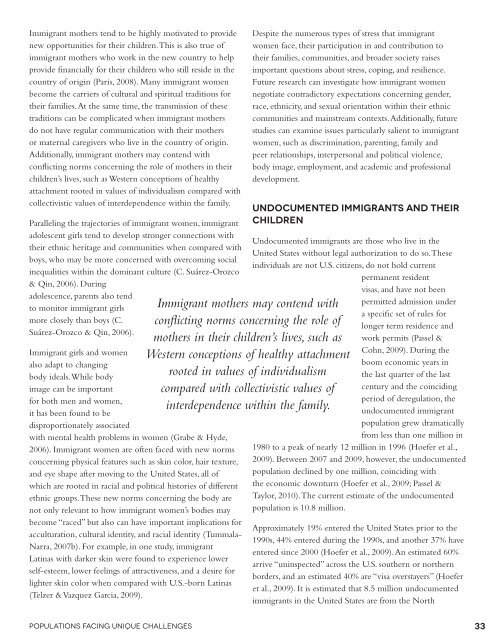Crossroads: The Psychology of Immigration in the New Century
Crossroads: The Psychology of Immigration in the New Century
Crossroads: The Psychology of Immigration in the New Century
Create successful ePaper yourself
Turn your PDF publications into a flip-book with our unique Google optimized e-Paper software.
Immigrant mo<strong>the</strong>rs tend to be highly motivated to provide<br />
new opportunities for <strong>the</strong>ir children. This is also true <strong>of</strong><br />
immigrant mo<strong>the</strong>rs who work <strong>in</strong> <strong>the</strong> new country to help<br />
provide f<strong>in</strong>ancially for <strong>the</strong>ir children who still reside <strong>in</strong> <strong>the</strong><br />
country <strong>of</strong> orig<strong>in</strong> (Paris, 2008). Many immigrant women<br />
become <strong>the</strong> carriers <strong>of</strong> cultural and spiritual traditions for<br />
<strong>the</strong>ir families. At <strong>the</strong> same time, <strong>the</strong> transmission <strong>of</strong> <strong>the</strong>se<br />
traditions can be complicated when immigrant mo<strong>the</strong>rs<br />
do not have regular communication with <strong>the</strong>ir mo<strong>the</strong>rs<br />
or maternal caregivers who live <strong>in</strong> <strong>the</strong> country <strong>of</strong> orig<strong>in</strong>.<br />
Additionally, immigrant mo<strong>the</strong>rs may contend with<br />
conflict<strong>in</strong>g norms concern<strong>in</strong>g <strong>the</strong> role <strong>of</strong> mo<strong>the</strong>rs <strong>in</strong> <strong>the</strong>ir<br />
children’s lives, such as Western conceptions <strong>of</strong> healthy<br />
attachment rooted <strong>in</strong> values <strong>of</strong> <strong>in</strong>dividualism compared with<br />
collectivistic values <strong>of</strong> <strong>in</strong>terdependence with<strong>in</strong> <strong>the</strong> family.<br />
Parallel<strong>in</strong>g <strong>the</strong> trajectories <strong>of</strong> immigrant women, immigrant<br />
adolescent girls tend to develop stronger connections with<br />
<strong>the</strong>ir ethnic heritage and communities when compared with<br />
boys, who may be more concerned with overcom<strong>in</strong>g social<br />
<strong>in</strong>equalities with<strong>in</strong> <strong>the</strong> dom<strong>in</strong>ant culture (C. Suárez-Orozco<br />
& Q<strong>in</strong>, 2006). Dur<strong>in</strong>g<br />
adolescence, parents also tend<br />
to monitor immigrant girls<br />
more closely than boys (C.<br />
Suárez-Orozco & Q<strong>in</strong>, 2006).<br />
Immigrant girls and women<br />
also adapt to chang<strong>in</strong>g<br />
body ideals. While body<br />
image can be important<br />
for both men and women,<br />
it has been found to be<br />
disproportionately associated<br />
with mental health problems <strong>in</strong> women (Grabe & Hyde,<br />
2006). Immigrant women are <strong>of</strong>ten faced with new norms<br />
concern<strong>in</strong>g physical features such as sk<strong>in</strong> color, hair texture,<br />
and eye shape after mov<strong>in</strong>g to <strong>the</strong> United States, all <strong>of</strong><br />
which are rooted <strong>in</strong> racial and political histories <strong>of</strong> different<br />
ethnic groups. <strong>The</strong>se new norms concern<strong>in</strong>g <strong>the</strong> body are<br />
not only relevant to how immigrant women’s bodies may<br />
become “raced” but also can have important implications for<br />
acculturation, cultural identity, and racial identity (Tummala-<br />
Narra, 2007b). For example, <strong>in</strong> one study, immigrant<br />
Lat<strong>in</strong>as with darker sk<strong>in</strong> were found to experience lower<br />
self-esteem, lower feel<strong>in</strong>gs <strong>of</strong> attractiveness, and a desire for<br />
lighter sk<strong>in</strong> color when compared with U.S.-born Lat<strong>in</strong>as<br />
(Telzer & Vazquez Garcia, 2009).<br />
Populations Fac<strong>in</strong>g Unique Challenges<br />
Immigrant mo<strong>the</strong>rs may contend with<br />
conflict<strong>in</strong>g norms concern<strong>in</strong>g <strong>the</strong> role <strong>of</strong><br />
mo<strong>the</strong>rs <strong>in</strong> <strong>the</strong>ir children’s lives, such as<br />
Western conceptions <strong>of</strong> healthy attachment<br />
rooted <strong>in</strong> values <strong>of</strong> <strong>in</strong>dividualism<br />
compared with collectivistic values <strong>of</strong><br />
<strong>in</strong>terdependence with<strong>in</strong> <strong>the</strong> family.<br />
Despite <strong>the</strong> numerous types <strong>of</strong> stress that immigrant<br />
women face, <strong>the</strong>ir participation <strong>in</strong> and contribution to<br />
<strong>the</strong>ir families, communities, and broader society raises<br />
important questions about stress, cop<strong>in</strong>g, and resilience.<br />
Future research can <strong>in</strong>vestigate how immigrant women<br />
negotiate contradictory expectations concern<strong>in</strong>g gender,<br />
race, ethnicity, and sexual orientation with<strong>in</strong> <strong>the</strong>ir ethnic<br />
communities and ma<strong>in</strong>stream contexts. Additionally, future<br />
studies can exam<strong>in</strong>e issues particularly salient to immigrant<br />
women, such as discrim<strong>in</strong>ation, parent<strong>in</strong>g, family and<br />
peer relationships, <strong>in</strong>terpersonal and political violence,<br />
body image, employment, and academic and pr<strong>of</strong>essional<br />
development.<br />
Undocumented Immigrants and <strong>The</strong>ir<br />
Children<br />
Undocumented immigrants are those who live <strong>in</strong> <strong>the</strong><br />
United States without legal authorization to do so. <strong>The</strong>se<br />
<strong>in</strong>dividuals are not U.S. citizens, do not hold current<br />
permanent resident<br />
visas, and have not been<br />
permitted admission under<br />
a specific set <strong>of</strong> rules for<br />
longer term residence and<br />
work permits (Passel &<br />
Cohn, 2009). Dur<strong>in</strong>g <strong>the</strong><br />
boom economic years <strong>in</strong><br />
<strong>the</strong> last quarter <strong>of</strong> <strong>the</strong> last<br />
century and <strong>the</strong> co<strong>in</strong>cid<strong>in</strong>g<br />
period <strong>of</strong> deregulation, <strong>the</strong><br />
undocumented immigrant<br />
population grew dramatically<br />
from less than one million <strong>in</strong><br />
1980 to a peak <strong>of</strong> nearly 12 million <strong>in</strong> 1996 (Hoefer et al.,<br />
2009). Between 2007 and 2009, however, <strong>the</strong> undocumented<br />
population decl<strong>in</strong>ed by one million, co<strong>in</strong>cid<strong>in</strong>g with<br />
<strong>the</strong> economic downturn (Hoefer et al., 2009; Passel &<br />
Taylor, 2010). <strong>The</strong> current estimate <strong>of</strong> <strong>the</strong> undocumented<br />
population is 10.8 million.<br />
Approximately 19% entered <strong>the</strong> United States prior to <strong>the</strong><br />
1990s, 44% entered dur<strong>in</strong>g <strong>the</strong> 1990s, and ano<strong>the</strong>r 37% have<br />
entered s<strong>in</strong>ce 2000 (Hoefer et al., 2009). An estimated 60%<br />
arrive “un<strong>in</strong>spected” across <strong>the</strong> U.S. sou<strong>the</strong>rn or nor<strong>the</strong>rn<br />
borders, and an estimated 40% are “visa overstayers” (Hoefer<br />
et al., 2009). It is estimated that 8.5 million undocumented<br />
immigrants <strong>in</strong> <strong>the</strong> United States are from <strong>the</strong> North<br />
33
















